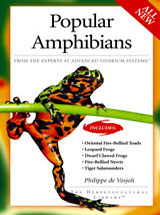The greatest difficulty in treating small amphibians comes from properly determining and administering the amount of drug required for treatment.
 |
There are currently few guidelines available for drug dosage in the veterinary treatment of amphibians. The two most practical references are a chapter by Kevin Wright, D.V.M., in Reptile Medicine and Surgery, edited by Douglas Mader, D.V.M., and Amphibian Medicine and Husbandry, the first practical reference on the veterinary treatment of amphibians, edited by Kevin Wright, D.V.M, and Brent Whitaker, D.V.M. Even with the latest references at hand, amphibian drug dosage and administration requires some competence, skills, and equipment.
Many amphibians weigh only a few grams, so you will need a gram scale to determine how much of a drug should be administered. You must also develop proficiency at metric conversions and dosage calculations. If you have several amphibians in the same size range, you can determine a more accurate per animal weight by weighing five or more amphibians together, then dividing by the number of amphibians.
The greatest difficulty in treating small amphibians comes from properly determining and administering the amount of drug required for treating a single amphibian. This is particularly true with drugs that have a narrow margin of safety. Drug dosage, which is typically in mg of drug per kg of body weight, needs to be calculated from the drug concentration of the product. For example, liquid Fenbendazole is typically sold at a concentration of 100 mg per ml (per cc). At a dosage of 100 mg per kg, treating a 2-gram newt or floating frog means effectively extracting 1/500 of a cc, something not feasible with most dosing syringes. The only way to easily do this is to dilute drug products to lower concentrations when treating small amphibians. Liquids for dilution must be sterile if the drug is to be injected, and they must be compatible chemically with the particular drug. Besides the problems of proper drug dosage, another difficulty in treating small amphibians is drug administration. Injectable drugs are generally easily administered with tuberculin syringes, but oral drugs require careful opening of a tiny mouth—not always the easiest task. In general, small wedges with rounded tips cut from plastic deli container lids are the tool of choice for opening the mouths of small frogs and newts. These thin wedges can be easily inserted between the edges of a mouth to permit opening, allowing medication to be administered to the amphibian with a small syringe.


